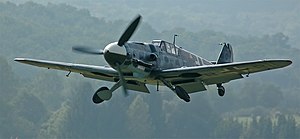Messerschmitt Bf 109E
| Bf 109 | |
|---|---|
 |
|
| A Hispano Aviación HA-1112 (c/n 156 C.4K-87 (D-FMBB), "FM+BB"), a license-built Messerschmitt Bf 109 G-2. Rebuilt by the EADS/Messerschmitt Foundation, Germany with a Daimler-Benz DB 605 engine as a G-6. The paint scheme is missing the Swastika, due to German law. | |
| Role | Fighter |
| Manufacturer |
Bayerische Flugzeugwerke (BFW) Messerschmitt AG |
| Designer | Willy Messerschmitt, Robert Lusser |
| First flight | 29 May 1935 |
| Introduction | February 1937 |
| Retired | 9 May 1945, Luftwaffe 27 December 1965, Spanish Air Force |
| Primary users |
Luftwaffe Hungarian Air Force Aeronautica Nazionale Repubblicana Royal Romanian Air Force |
| Number built | 33,984 +239 HA-1112 +603 Avia S-199 |
| Variants |
Avia S-99/S-199 Hispano Aviacion Ha 1112 |
The Messerschmitt Bf 109 is a German World War II fighter aircraft that was the backbone of the Luftwaffe's fighter force. The Bf 109 first saw operational service in 1937 during the Spanish Civil War and was still in service at the dawn of the jet age at the end of World War II in 1945. It was one of the most advanced fighters of the era, including such features as all-metal monocoque construction, a closed canopy, and retractable landing gear. It was powered by a liquid-cooled, inverted-V12 aero engine. From the end of 1941, the Bf 109 was steadily being supplemented by the Focke-Wulf Fw 190.
It was commonly called the Me 109, most often by Allied aircrew and even among the German aces themselves, even though this was not the official German designation. The designation "Messerschmitt Bf 109" was issued by the Ministry of Aviation (German: Reichsluftfahrtministerium) and represents the firm that originally built them, the "Bavarian Aircraft Works", or Bayerische Flugzeugwerke (BFW) in German. The confusion arises because design work began in 1934 at the BFW firm and, as was customary, the model was designated by the prefix Bf. On July 11, 1938 the company was renamed Messerschmitt AG due to Willy Messerschmitt becoming its new owner, and the prefix Me was applied to all new models after that date, whilst existing types retained their Bf prefix.
It was designed by Willy Messerschmitt and Robert Lusser, who worked at Bayerische Flugzeugwerke during the early to mid-1930s.
...
Wikipedia
